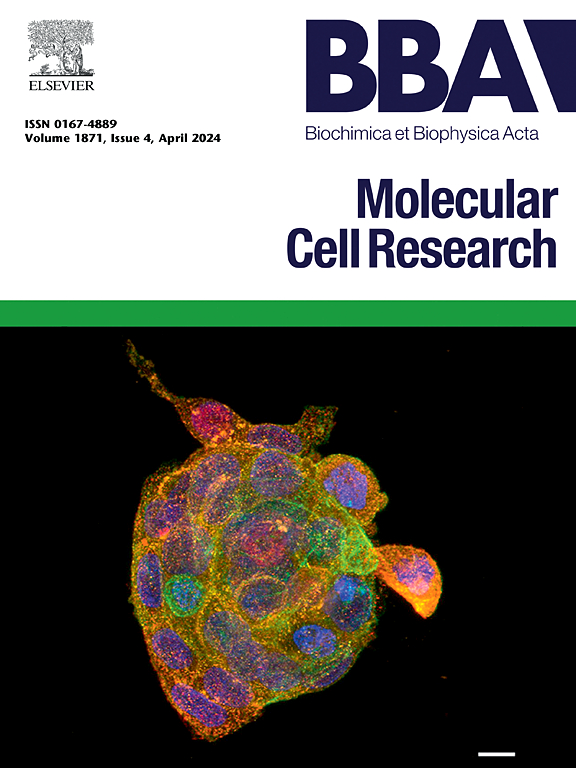NLRX1 attenuates endoplasmic reticulum stress via STING in cardiac hypertrophy
IF 4.6
2区 生物学
Q1 BIOCHEMISTRY & MOLECULAR BIOLOGY
Biochimica et biophysica acta. Molecular cell research
Pub Date : 2024-09-30
DOI:10.1016/j.bbamcr.2024.119852
引用次数: 0
Abstract
Endoplasmic reticulum stress-induced cell apoptosis is a pivotal mechanism underlying the progression of cardiac hypertrophy. NLRX1, a member of the NOD-like receptor family, modulates various cellular processes, including STING, NF-κB, MAPK pathways, reactive oxygen species production, essential metabolic pathways, autophagy and cell death. Emerging evidence suggests that NLRX1 may offer protection against diverse cardiac diseases. However, the impacts and mechanisms of NLRX1 on endoplasmic reticulum stress in cardiac hypertrophy remains largely unexplored. In our study, we observed that the NLRX1 and phosphorylated STING (p-STING) were highly expressed in both hypertrophic mouse heart and cellular model of cardiac hypertrophy. Whereas over-expression of NLRX1 mitigated the expression levels of p-STING, as well as the endoplasmic reticulum stress markers, including transcription activating factor 4 (ATF4), C/EBP homologous protein (CHOP) and the ratios of phosphorylated PERK to PERK, phosphorylated IRE1 to IRE1 and phosphorylated eIF2α to eIF2α in an Angiotensin II (Ang II)-induced cellular model of cardiac hypertrophy. Importantly, the protective effects of NLRX1 were attenuated upon pretreatment with the STING agonist, DMXAA. Our findings provide the evidence that NLRX1 attenuates the PERK-eIF2α-ATF4-CHOP axis of endoplasmic reticulum stress response via inhibition of p-STING in Ang II-treated cardiomyocytes, thereby ameliorating the development of cardiac hypertrophy.
NLRX1 通过 STING 减轻心肌肥厚中的内质网应激反应
内质网应激诱导的细胞凋亡是心肌肥厚进展的关键机制。NLRX1 是 NOD 样受体家族的成员,它能调节各种细胞过程,包括 STING、NF-κB、MAPK 途径、活性氧生成、基本代谢途径、自噬和细胞死亡。新的证据表明,NLRX1 可预防多种心脏疾病。然而,NLRX1 对心脏肥大中内质网应激的影响和机制在很大程度上仍未得到探索。在我们的研究中,我们观察到 NLRX1 和磷酸化 STING(p-STING)在肥厚小鼠心脏和心脏肥厚细胞模型中均高表达。而在血管紧张素 II(Ang II)诱导的心脏肥大细胞模型中,过度表达 NLRX1 可减轻 p-STING 的表达水平,以及内质网应激标志物,包括转录激活因子 4(ATF4)、C/EBP 同源蛋白(CHOP)和磷酸化 PERK 与 PERK、磷酸化 IRE1 与 IRE1 和磷酸化 eIF2α 与 eIF2α 的比率。重要的是,在 STING 激动剂 DMXAA 的预处理下,NLRX1 的保护作用减弱。我们的研究结果提供了证据,证明 NLRX1 通过抑制 Ang II 处理的心肌细胞中的 p-STING 来减弱内质网应激反应的 PERK-eIF2α-ATF4-CHOP 轴,从而改善心脏肥大的发展。
本文章由计算机程序翻译,如有差异,请以英文原文为准。
求助全文
约1分钟内获得全文
求助全文
来源期刊
CiteScore
10.00
自引率
2.00%
发文量
151
审稿时长
44 days
期刊介绍:
BBA Molecular Cell Research focuses on understanding the mechanisms of cellular processes at the molecular level. These include aspects of cellular signaling, signal transduction, cell cycle, apoptosis, intracellular trafficking, secretory and endocytic pathways, biogenesis of cell organelles, cytoskeletal structures, cellular interactions, cell/tissue differentiation and cellular enzymology. Also included are studies at the interface between Cell Biology and Biophysics which apply for example novel imaging methods for characterizing cellular processes.

 求助内容:
求助内容: 应助结果提醒方式:
应助结果提醒方式:


